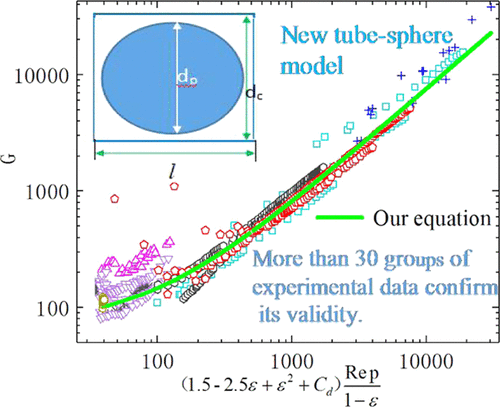当前位置:
X-MOL 学术
›
Ind. Eng. Chem. Res.
›
论文详情
Our official English website, www.x-mol.net, welcomes your
feedback! (Note: you will need to create a separate account there.)
Derivation and Validation of a New Porous Media Resistance Formula Based on a Tube-Sphere Model
Industrial & Engineering Chemistry Research ( IF 3.8 ) Pub Date : 2020-08-31 , DOI: 10.1021/acs.iecr.0c02197 Chen Zhaodong 1, 2 , Zheng Kuncan 1, 2 , Wang Xiao 1 , Han Fuling 1 , Guan Chong 1 , Bu Juanjuan 1
Industrial & Engineering Chemistry Research ( IF 3.8 ) Pub Date : 2020-08-31 , DOI: 10.1021/acs.iecr.0c02197 Chen Zhaodong 1, 2 , Zheng Kuncan 1, 2 , Wang Xiao 1 , Han Fuling 1 , Guan Chong 1 , Bu Juanjuan 1
Affiliation

|
Porous media play a vital role in daily life and industrial production, but their flow resistance calculation is always a difficult at the same time a hot topic of research. In this paper, a tube-sphere combination model is established based on the actual porous media structure and flow characteristics. The model considers the flow resistance of porous media as the superposition of tube flow viscous resistance, the resistance of flowing around a small ball and through the variable diameter of a channel. From this, a new resistance equation without any empirical constant is derived. Based on 35 sets of experimental data collected from the literature, this paper compares and verifies the derived formula, the classical Ergun equation and the Carman equation under small Reynolds number. The experimental parameters include particle size range: 0.0375–56.8 mm; porosity range: 0.32–0.882; Reynolds number range: 0.006–10 730. It is found that in most cases, the derived formula has better adaptability than the Ergun equation and is equivalent to the prediction accuracy of the Carman formula in a Darcy regime. However, for the pre-Darcy regime with smaller Reynolds number, the experimental data itself are quite different, and the calculation results of the three formulas are quite different from the experimental value. The maximum error of the Ergun equation is 49%, that of the Kozeny–Carman equation is 39%, and that of the derivation equation is 37%, indicating that the region may have completely different resistance mechanisms.
中文翻译:

基于管球模型的新型多孔介质阻力公式的推导与验证
多孔介质在日常生活和工业生产中起着至关重要的作用,但同时其流阻计算始终是一个困难的研究热点。本文根据实际的多孔介质结构和流动特性,建立了管-球组合模型。该模型将多孔介质的流动阻力视为管流动粘性阻力,围绕小球流动并通过可变直径通道的阻力的叠加。由此,得出了没有任何经验常数的新电阻方程。基于从文献中收集的35组实验数据,本文比较并验证了在小雷诺数下的推导公式,经典的Ergun方程和Carman方程。实验参数包括粒径范围:0。0375–56.8毫米;孔隙率范围:0.32-0.882;雷诺数范围:0.006–10730。发现在大多数情况下,得出的公式比Ergun公式具有更好的适应性,并且等于达西体制中Carman公式的预测精度。但是,对于雷诺数较小的达西前体制,实验数据本身是完全不同的,并且三个公式的计算结果与实验值完全不同。Ergun方程的最大误差为49%,Kozeny-Carman方程的最大误差为39%,推导方程的最大误差为37%,这表明该区域可能具有完全不同的电阻机制。所推导的公式比Ergun公式具有更好的适应性,并且等效于Darcy体制中Carman公式的预测精度。但是,对于雷诺数较小的达西前体制,实验数据本身是完全不同的,并且三个公式的计算结果与实验值完全不同。Ergun方程的最大误差为49%,Kozeny-Carman方程的最大误差为39%,微分方程的最大误差为37%,表明该区域可能具有完全不同的电阻机制。所推导的公式比Ergun公式具有更好的适应性,并且等效于Darcy体制中Carman公式的预测精度。但是,对于雷诺数较小的达西前体制,实验数据本身是完全不同的,并且三个公式的计算结果与实验值完全不同。Ergun方程的最大误差为49%,Kozeny-Carman方程的最大误差为39%,推导方程的最大误差为37%,这表明该区域可能具有完全不同的电阻机制。这三个公式的计算结果与实验值有很大差异。Ergun方程的最大误差为49%,Kozeny-Carman方程的最大误差为39%,推导方程的最大误差为37%,这表明该区域可能具有完全不同的电阻机制。这三个公式的计算结果与实验值有很大差异。Ergun方程的最大误差为49%,Kozeny-Carman方程的最大误差为39%,推导方程的最大误差为37%,这表明该区域可能具有完全不同的电阻机制。
更新日期:2020-10-07
中文翻译:

基于管球模型的新型多孔介质阻力公式的推导与验证
多孔介质在日常生活和工业生产中起着至关重要的作用,但同时其流阻计算始终是一个困难的研究热点。本文根据实际的多孔介质结构和流动特性,建立了管-球组合模型。该模型将多孔介质的流动阻力视为管流动粘性阻力,围绕小球流动并通过可变直径通道的阻力的叠加。由此,得出了没有任何经验常数的新电阻方程。基于从文献中收集的35组实验数据,本文比较并验证了在小雷诺数下的推导公式,经典的Ergun方程和Carman方程。实验参数包括粒径范围:0。0375–56.8毫米;孔隙率范围:0.32-0.882;雷诺数范围:0.006–10730。发现在大多数情况下,得出的公式比Ergun公式具有更好的适应性,并且等于达西体制中Carman公式的预测精度。但是,对于雷诺数较小的达西前体制,实验数据本身是完全不同的,并且三个公式的计算结果与实验值完全不同。Ergun方程的最大误差为49%,Kozeny-Carman方程的最大误差为39%,推导方程的最大误差为37%,这表明该区域可能具有完全不同的电阻机制。所推导的公式比Ergun公式具有更好的适应性,并且等效于Darcy体制中Carman公式的预测精度。但是,对于雷诺数较小的达西前体制,实验数据本身是完全不同的,并且三个公式的计算结果与实验值完全不同。Ergun方程的最大误差为49%,Kozeny-Carman方程的最大误差为39%,微分方程的最大误差为37%,表明该区域可能具有完全不同的电阻机制。所推导的公式比Ergun公式具有更好的适应性,并且等效于Darcy体制中Carman公式的预测精度。但是,对于雷诺数较小的达西前体制,实验数据本身是完全不同的,并且三个公式的计算结果与实验值完全不同。Ergun方程的最大误差为49%,Kozeny-Carman方程的最大误差为39%,推导方程的最大误差为37%,这表明该区域可能具有完全不同的电阻机制。这三个公式的计算结果与实验值有很大差异。Ergun方程的最大误差为49%,Kozeny-Carman方程的最大误差为39%,推导方程的最大误差为37%,这表明该区域可能具有完全不同的电阻机制。这三个公式的计算结果与实验值有很大差异。Ergun方程的最大误差为49%,Kozeny-Carman方程的最大误差为39%,推导方程的最大误差为37%,这表明该区域可能具有完全不同的电阻机制。











































 京公网安备 11010802027423号
京公网安备 11010802027423号